<< Previous | Displaying results 4651-4700 of 6769 for "" | Next >>
At some point after the war, Sophie received this small stuffed bear (about three inches high) as a present from her mother. She named it “Refugee,” just like she and her mother were refugees of the war.
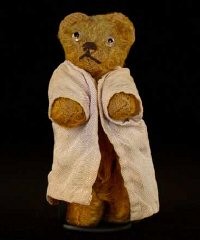
A replica of "Refugee" bear and a photo of a Darfurian child refugee, items taken by Commander Mark Polansky (pictured) on a December 2006 Space Shuttle mission.
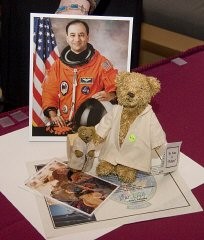
Dr. Sophie Turner-Zaretsky, Space Shuttle Discovery Commander Mark Polansky, and United States Holocaust Memorial Museum chief of staff Bill Parsons. They are holding a replica of "Refugee" bear and a photo of a Darfurian child refugee, items taken by Commander Polansky on a December 2006 Space Shuttle mission.
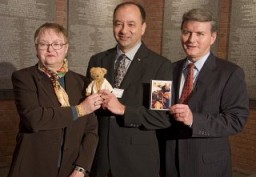
Group portrait of the members of the Zionist pioneer youth group, Ha-Shomer ha-Tsa'ir Hachshara. Kalisz, Poland, May 1, 1935.
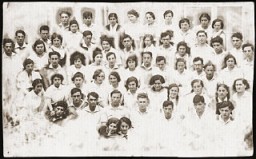
A soccer team of the Jewish sports club, Ha-koach (The Strength). Kalisz, Poland, ca. 1933.
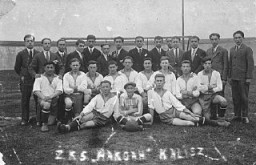
American judges (top row, seated) during the Doctors Trial, case #1 of the Subsequent Nuremberg Proceedings. Presiding Judge Walter B. Beals is seated second from the left. Nuremberg, Germany, December 9, 1946–August 20, 1947.
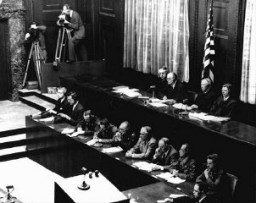
The prosecution team during the Doctors' Trial. Nuremberg, Germany, December 9, 1946-August 20, 1947.
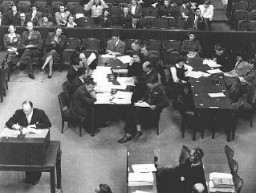
Alexander G. Hardy, associate counsel for the prosecution, during the Doctors Trial. Nuremberg, Germany, December 9, 1946-August 20, 1947.
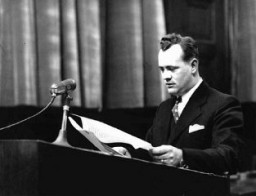
Chief Prosecutor James M. McHaney during the Doctors' Trial. Nuremberg, Germany, December 9, 1946-August 20, 1947.

Clandestine photograph of a Polish political prisoner and medical experiment victim in the Ravensbrück concentration camp. Prisoners in the Ravensbrück concentration camp took several clandestine photographs as evidence of the medical experiments conducted on them. The camp was the site of bone-grafting experiments and experiments to test newly developed sulfa drugs.Pictured here, Bogumila Jasuik was chosen as one of the 74 "rabbits" for medical experimentation. German doctors experimented…
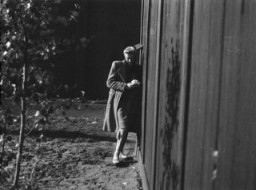
Professor Raphael Lemkin, left, and Ricardo Alfaro of Panama (chairman of the Assembly's Legal Committee) in conversation before the plenary meeting of the General Assembly at which the Convention on the Prevention and Punishment of Genocide was approved.
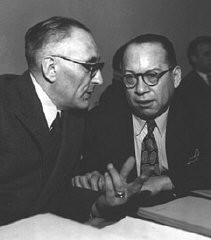
Raphael Lemkin (right) with Ambassador Amado of Brazil (left) before a plenary session of the General Assembly at which the Convention on the Prevention and Punishment of Genocide was approved. Palais de Chaillot, Paris, December 11, 1948.
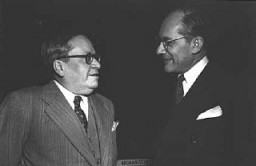
Representatives of four states who ratified the Genocide Convention on October 14, 1950. Seated from left to right: Dr. John P. Chang (Korea), Dr. Jean Price-Mars (Haiti), Assembly President Amb. Nasrollah Entezam (Iran), Amb. Jean Chauvel (France), Mr. Ruben Esquivel de la Guardia (Costa Rica), (standing, left to right) Dr. Ivan Kerno (Asst. Secretary General for Legal Affairs), Mr. Trygve Lie (Secretary-General of U.N.), Mr. Manuel A. Fournier Acuna (Costa Rica), and Dr. Raphael Lemkin (crusader for the…
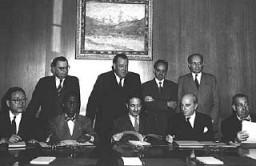
Panel from the exhibition A Dangerous Lie: The Protocols of the Elders of Zion which was on display at the United States Holocaust Memorial Museum from 2006–18. The exhibition explored the continuing impact of the most widely distributed antisemitic publication of modern times.
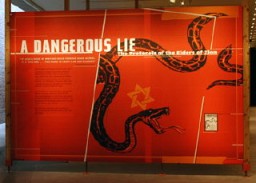
Group portrait of former Bielski partisans from Nowogrodek taken in the Foehrenwald displaced persons camp. Germany, April 3, 1948.
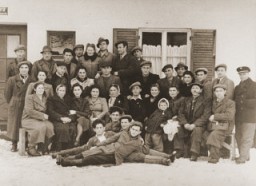
Fire brigade arrives at the Reichstag (German parliament) building. Despite fire-fighting efforts, the building was virtually destroyed by fires set at several places in the building. Berlin, Germany, February 27, 1933.

Firemen in the Reichstag (German parliament) building after it was damaged by arson. Berlin, Germany, February 27, 1933.
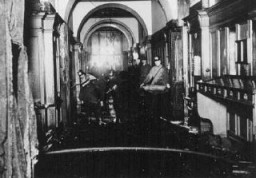
The Berlin Fire Brigade extinguishes the fire at the Reichstag (German parliament). Berlin, Germany, February 27, 1933.
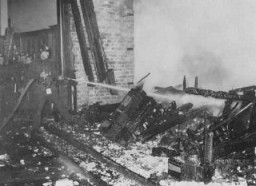
Onlookers in front of the Reichstag (German parliament) building the day after it was damaged by fire. On this same day, the Nazis implemented the Decree of the Reich President for the Protection of the People and the State. It was one of a series of key decrees, legislative acts, and case law in the gradual process by which the Nazi leadership moved Germany from a democracy to a dictatorship. Berlin, Germany, February 28, 1933.
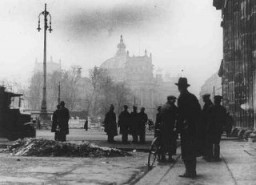
Identification picture of Erich Mühsam taken in the Oranienburg concentration camp. Mühsam, an anarchist and a pacifist, worked as an editor and writer; he was imprisoned during World War I for opposing the war. Arrested during the massive roundup of Nazi political opponents following the Reichstag fire (February 27, 1933), Mühsam was tortured to death in Oranienburg on July 11, 1934. Oranienburg, Germany, February 3, 1934.
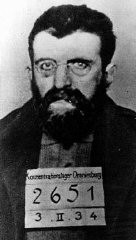
The former Mufti of Jerusalem, Hajj Amin al-Husayni, meets Hitler for the first time. Berlin, Germany, November 28, 1941.
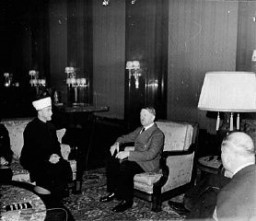
Hajj Amin al-Husayni in the company of German SS and Bosnian members of the Waffen-SS during an official visit to Bosnia, ca. 1943.
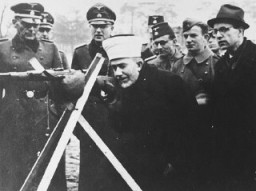
Recently appointed as German chancellor, Adolf Hitler greets President Paul von Hindenburg in Potsdam, Germany, on March 21, 1933. This pose was designed to project an image of Hitler as non-threatening to the established order. This particular image is from a popular postcard. The photo also appeared widely in both the German and international press. Hitler appears in civilian dress, bowing in deference to the heavily decorated von Hindenburg. The March 5, 1933, elections had conferred legitimacy on…
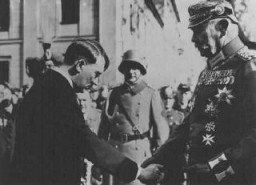
Nazi Storm Troopers (SA) block the entrance to a trade union building that they have occupied. SA detachments occupied union offices nationwide, forcing the dissolution of the unions. Berlin, Germany, May 2, 1933.
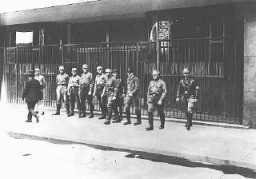
A crowd of saluting Germans surrounds Adolf Hitler's car as he leaves the Reich Chancellery following a meeting with President Paul von Hindenburg. Berlin, Germany, November 19, 1932.
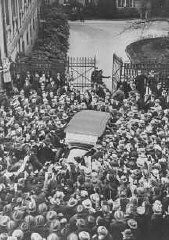
A march supporting the Nazi movement during an election campaign in 1932. Berlin, Germany, March 11, 1932.
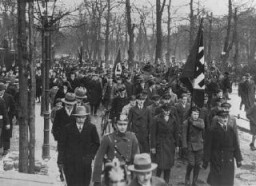
Members of the Storm Troopers (SA) march through the Brandenburg gate. Berlin, Germany, April 8, 1933.
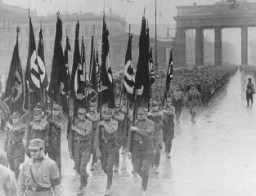
The Nazis used public displays to spread their ideas of race. The chart shown here is titled "The Biology of Growth," and is labeled "Stages of Growth for Members of the Nordic Race."
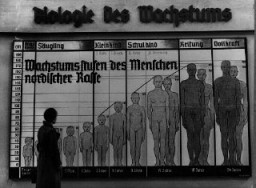
Establishing racial descent by measuring an ear at the Kaiser Wilhelm Institute for Anthropology. Germany, date uncertain.
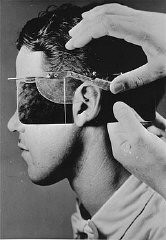
At the Kaiser Wilhelm Institute for Anthropology, Human Genetics, and Eugenics, a racial hygienist measures a woman's features in an attempt to determine her racial ancestry. Berlin, Germany, date uncertain.
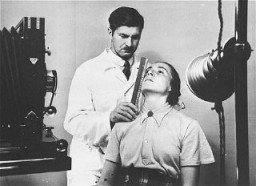
Assembly point for Poles displaced by the German Race and Resettlement Main Office (RuSHA). Sol, Poland, September 24, 1940.
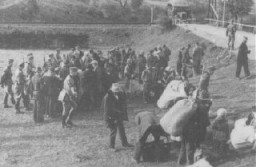
The Germans destroyed symbols of the Polish state. Here, German soldiers stand by the toppled Grunwald monument in Krakow. Poland, 1940.
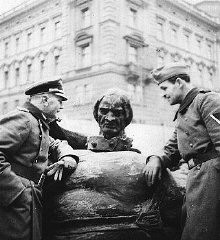
Portrait of Hilde and Gerrit Verdoner, with four bridesmaids, on their wedding day. The bridesmaids are: Jetty Fontijn (far left), Letty Stibbe (second from right), Miepje Slulizer (right), and Fanny Schoenfeld (standing, back). Amsterdam, the Netherlands, December 12, 1933.
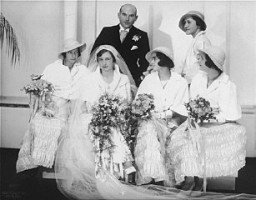
Ruth Kohn (top row, second from left) and her classmates at a school in Prague. Prague, Czechoslovakia, 1928.
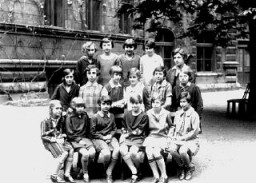
Scene of prewar economic life: Jewish vendors sell their wares at an outdoor market in front of the Stara synagogue. Krakow, Poland, 1936.
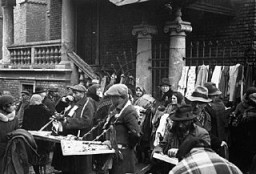
Berta Rosenheim poses with a large cone, traditionally filled with sweets and stationery, on her first day of school. Leipzig, Germany, April 1929.
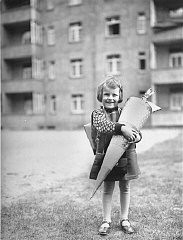
An antisemitic cartoon published in Dr. Kurt Plischke's Der Jude als Rassenschaender: Eine Anklage gegen Juda und eine Mahnung an die deutschen Frauen und Maedchen (The Jew as Race Defiler: An Accusation against Judah and a Warning to German Women and Girls). Germany, ca. 1935.
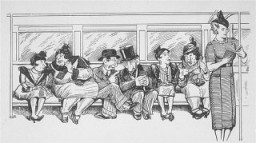
Three Jewish businessmen are forced to march down a crowded Leipzig street while carrying signs reading: "Don't buy from Jews. Shop in German businesses!" Leipzig, Germany, 1935.
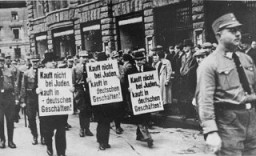
Scene during the boycott of Jewish businesses. A sign on truck carrying Storm Troopers (SA) urges "Germans! Defend yourselves. Don't buy from Jews." Berlin, Germany, April 1, 1933.
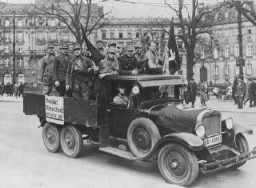
Spectators in the stands of the Zeppelinfeld look on as Adolf Hitler's car moves towards the speakers' platform at the opening of Reichsparteitag (Reich Party Day) ceremonies in Nuremberg. The Zeppelinfeld was part of the Nazi Party rally grounds. Nuremberg, Germany, September 1935.
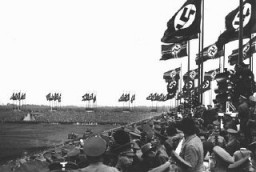
A postcard of the SS St. Louis. May 1939. The plight of German-Jewish refugees, persecuted at home and unwanted abroad, is illustrated by the May 13, 1939, voyage of the SS St. Louis.

Refugees aboard the St. Louis wait to hear whether Cuba will grant them entry. Off the coast of Havana, Cuba, June 3, 1939.

German women at work in the offices of the German Census Bureau. The board gives directions for tabulation: the center column instructs that number 3 is the indicator to be used for Jews. Germany, 1933.
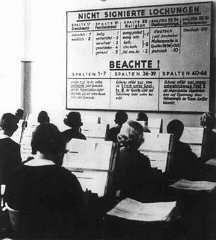
View of a barbed-wire fence separating part of the ghetto in Krakow from the rest of the city. Krakow, Poland, date uncertain. During the Holocaust, the creation of ghettos was a key step in the Nazi process of brutally separating, persecuting, and ultimately destroying Europe's Jews. Ghettos were often enclosed districts that isolated Jews from the non-Jewish population and from other Jewish communities.
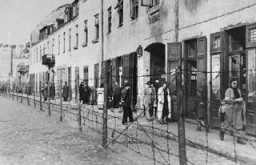
Deportation from the Krakow ghetto at the time of the ghetto's liquidation. Krakow, Poland, March 1943.
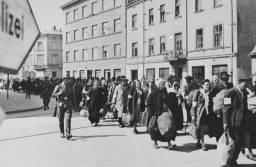
Jews forced to move into the Lodz ghetto. Lodz, Poland, date uncertain. During the Holocaust, the creation of ghettos was a key step in the Nazi process of brutally separating, persecuting, and ultimately destroying Europe's Jews. Ghettos were often enclosed districts that isolated Jews from the non-Jewish population and from other Jewish communities.
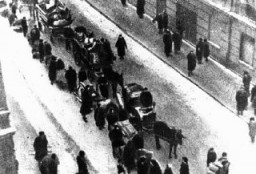
Forced laborers work on the construction of a wall around the Warsaw ghetto area. The Germans announced the construction of a ghetto in October 1940 and closed the ghetto off from the rest of Warsaw in mid-November 1940.
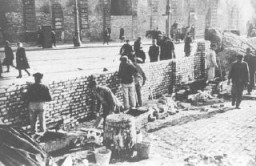
Footbridge over Chlodna Street, connecting two parts of the Warsaw ghetto. The street below was not part of the ghetto. Warsaw, Poland, date uncertain.
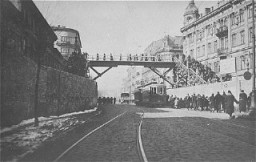
The footbridge over Zgierska Street that joined the two parts of the Lodz ghetto. The street itself was not part of the ghetto. Lodz, Poland, ca. 1941.
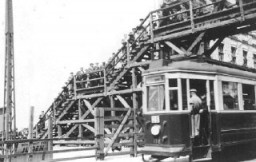
A Jewish man and child at forced labor in a factory in the Lodz ghetto. Lodz, Poland, date uncertain.
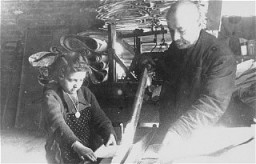
We would like to thank Crown Family Philanthropies, Abe and Ida Cooper Foundation, the Claims Conference, EVZ, and BMF for supporting the ongoing work to create content and resources for the Holocaust Encyclopedia. View the list of donor acknowledgement.